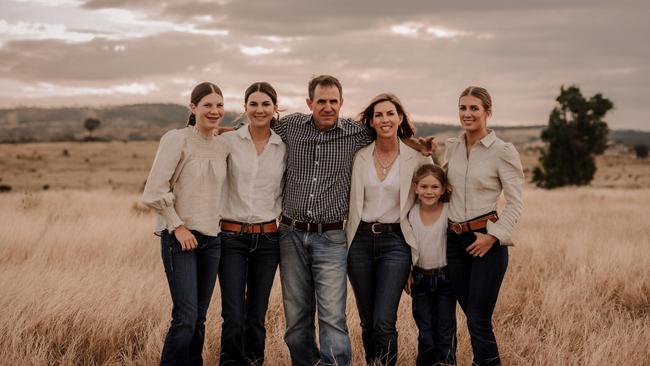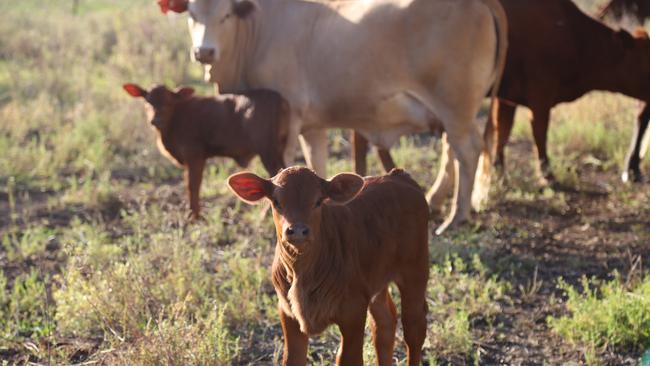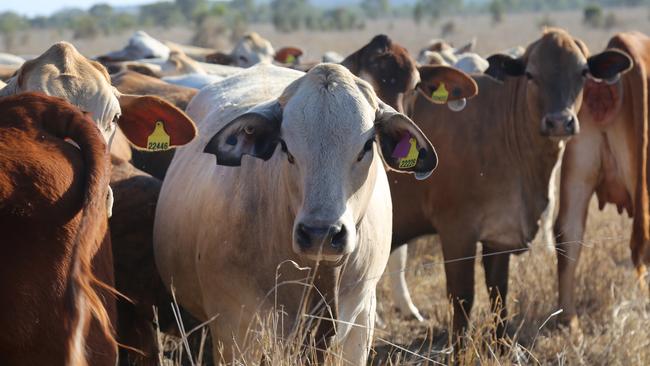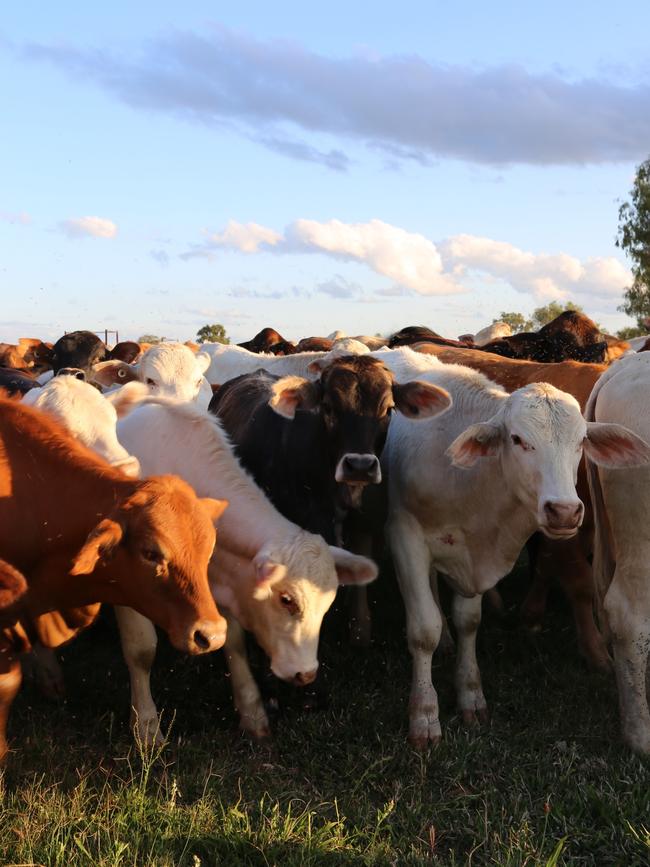Andrew and Claire Mactaggart have improved their beef herd’s productivity
Grazing management, alongside genomics has given this Central Queensland family the ability to use objective measurements to improve productivity gains in their beef herd.
A focus on grazing management, lifting carrying capacity along with using genomics to measure specific traits have provided the Mactaggart family with significant productivity gains in their Central Queensland beef breeding and backgrounding business.
Andrew and Claire Mactaggart, along with their daughters Anna, 21, Eliza, 20, Sarah, 16, Grace, 10, and Andrew’s parents John and Julien, run a 33,000ha beef operation across two main aggregations.
Balcomba near Duaringa in Central Queensland is 22,500ha and used predominantly for breeding cattle, while to the south is Wirranda which is 10,000ha near Moura, which is mostly used for backgrounding.
The Mactaggarts breeding program, is an open-ended composite herd with a target of under 50 per cent Bos Indicus content, and the remainder an even mix of British and European genetics.
“We’ve reduced the Bos Indicus content down to 35-40 per cent, otherwise the blend has remained fairly static since we started,” Andrew said.
He said they started with the composites in about 1995.
“The main objective of a composite herd is to maximise hybrid vigour in a simple to manage system — giving us a real lift in fitness and functional traits. Hybrid vigour gives us the ability to shift the needle on those lowly heritable traits.”

The European content in the composites is predominantly Charolais, while the British-breed content was originally Hereford, but has had influences of Shorthorn via Droughtmaster and in recent years has been more Red Angus. Stabilizer composites are also used continuing with the Euro British blend.
“We breed composites for their productivity and market suitability in the confines of the environment we operate in,” Andrew said.
BIG INFLUENCE
Paringa Livestock from Yea have had a big influence on the Mactaggarts herd in the past six years, after they entered into a contract breeding arrangement.
The Mactaggarts were sending semen from elite Brahman bulls to Paringa to join to Red Angus and Red Stabilizer cows, and then buying the progeny back.
Andrew said they haven’t done contract breeding for two years but will do it again in the future, as required. They have continued to buy a few Bos Taurus bulls from Paringa.
The family also breed the majority of their own replacement bulls.
“We multiply the high end Paringa genetics in our systems and environment and select from that,” Andrew said.
Bulls are joined as yearlings, and the bull battery is turned over every three years, to shorten the genetic interval.
The development of Northern Genomics has given them the ability to use objective measurements, particularly for fertility traits, in addition to their raw data and systems-based selection.
“We have had a high focus on poll genetics in the past five years and we haven’t used a horned bull for three seasons. We have about 50 per cent of bulls now PP (homozygous true poll).”
“In 2017 we measured 3 per cent poll genetics, which was a wake up for us, we are now probably around 75 per cent, in our calf crop”
“Genomic testing has been a significant step forward.”

GENOMIC WAY
Andrew said they were part of a cohort for a genomics testing program with Meat and Livestock Australia in partnership with the University of Queensland to identify fertility traits in northern beef herds.
The Mactaggarts entered several cohorts of yearling heifers between 2017 and 2023 to the project and the heifers were scanned at approximately 300kg to determine the presence of a corpus luteum, indicating oestrus cycling, then scanned for pregnancy and foetal age after joining, and again after rebreed
The scans determined approximate age of puberty and ability to rebreed while lactating (known as P4M – pregnant four months after calving).
Andrew said it allowed them to benchmark their herd.
“We have seen and measured significant progress in our herd.”
Genomics for puberty indicates 70 per cent of females are now above the Northern industry average up from 47 per cent since 2017, while P4M was at 84 per cent of females above the Northern industry average, up from 61 per cent.
While a lot of the females had already been DNA tested, they will continue to use genomics as a selection tool for replacement bulls and every few years test the heifers too, to keep their data current.
HERD PERFORMANCE
Females are joined for 12 weeks, starting in the second week of December.
Heifers are joined as yearlings so they calve at two-years-old. They have a target joining weight of 270kg.
“If the seasons are with us, we can get them to joining weight on grass but if it is a below average season, we give them an additional performance feed of molasses, urea and protein meal mix to get them to joining weight,” Andrew said.
“Our average annual gain on grass is 0.5kg/day,”
All females are pregnancy-tested, with mature cows at about 90 per cent scanned-in-calf and heifers at 82 per cent.
All empty females are sold, as are those that don’t present a calf after calving.
About 60-65 per cent of the heifer drop are joined.
Females are selected for mothering ability and survivability traits.
Longevity is a key trait of the herd, with cows staying in the herd provided they are fit for function until they are 14-years-old.
Steers are targeted toward the 100-days on grain feedlot market and sold direct to feedlot as heavy weights.
“We aim to average over 480kg on induction at the feedlot,” Andrew said.
“All our home-bred cattle are grass-fed eligible, we supplementary feed with urea and molasses during extended dry periods, providing we have the dry feed to do it.
“Maintaining ground cover is our highest priority.”

GRAZING PROFIT
The Mactaggarts use time-controlled grazing methods, with the numbers of days a paddock is grazed dependent on the carrying capacity and desired rest period.
Rest periods are adjusted to suit the rate of plant growth.
Broadly the cattle are run in 15-18 mobs and move through 500 paddocks, meaning on average, greater than 95 per cent of the paddocks are in rest and recovery at any one time.
Andrew said they started moving to time-controlled grazing in 2001, after attending an RCS Grazing for Profit course in 1996.
“We initially focused on getting some rest into all our country and then further subdivision to shorten graze periods and increase density.”
“Initially we fenced for more even utilisation. Improved ground cover and pasture species diversity, has led to better rainfall use efficiency through increased infiltration rate and less run-off. Annual photographs track changes in the landscape over time,” Claire said.
Claire said stock handling has changed, with better knowledge and training around animal behaviour.
“When you move to a more intensive system, your skill set has to move to another level.”
“From an animal husbandry perspective our change in grazing practice has also given us flexibility, we have fewer mobs and easier access to the cattle.”
They have multiple sources of water, including dams, underground and the Mackenzie River.
“Where we can we have troughs and piped water, with a target of less than 1km walk to water and maximum of 1.2km. Solar pumps have seen a significant improvement in this area,” Andrew said.
“Apart from regulation compliance we use almost no treatment for ticks, which is why we can have a lower Brahman content now,” Andrew said.
It has also meant carrying capacity has increased, with carrying capacity up 20 to 40 per cent across the properties.
“Since 2001 when we changed our grazing system there has been a steady increase in carrying capacity.”
To be able to measure this they use stock days per ha per 100mm of rain.
The annual average rainfall is 600mm, with summer dominant rain.
LAND HEALTH
The Mactaggarts take a practical approach to land management and have a strong commitment to innovation. They have a soil carbon project across the majority of the land, which has been going for about two years.
“We don’t have any results yet, apart from baseline, but I am happy to progress forward,” Andrew said.
“I think long-term carbon is going to be one part of measuring of natural capital/ecosystem services. I believe in the future there will be recognition of ground cover, water, tree density, animal habitat, in addition to carbon.”
With many sustainable practices already in place, Andrew said one of the difficult things about the carbon project was establishing a practice change.
“Current methodology makes it harder for those who are early adopters. Most of our practice change has been, increasing stock density, shortening graze period, and legume planting.”
“We are confident we can go to 30 to 40 per cent canopy cover without any production loss.” “Photosynthesis is the main driver of soil health and during the extended dry periods we get, evergreen trees are the only thing photosynthesizing.

“Additional benefits of moderate canopy cover and stem density are temperature control, reduced transpiration and significant synergistic soil health outcomes and other ecosystem services through species diversity.”
Since 2017 they have been dealing with pasture dieback, a condition that kills sown and native summer growing grass.
“It has had a significant impact on our carrying capacity and landscape. One benefit is it has given us the opportunity to establish new legumes in our pastures, further increasing diversity” Andrew said.
On-farm technology use includes, using Optiweigh, a portable walk-over weighing device, used to track weights, telemetry systems for water monitoring, farm security and Wi-Fi has just been installed in the cattle yards.
FAMILY FOCUS
The Mactaggarts have a strong sense of their family business and a strong focus on the people aspect of the operation.
They have several long-term staff who have been with them for more than 10 years and together they are implementing a structured, long term business plan. They hold family business meetings quarterly and an annual strategy meeting.
“People, Land, Livestock are our areas of focus. We invest and encourage continuous growth and wellbeing,” Claire said.
While two of their children were still at school, Anna is studying at Marcus Oldham and Eliza is working on a west Queensland station, before further study.
“There’s definitely no pressure on our children to be in agriculture but I’d say they will all be in involved in some way,” Andrew said.
“We will look to grow the business to incorporate them if that is what they want to do.”
Both Andrew and Claire contribute to the broader beef industry.
Andrew, who started back on the farm in 1997, is a graduate of Marcus Oldham, and is involved in industry organisations, serving as a past chairman of the Beef Australia Commercial Cattle Committee and a director of Beef Australia, while Claire, is an agribusiness graduate and journalist, and is currently a director of Beef Australia since 2018, and treasurer of ICPA Capricornia.
Andrew said he sees a bright future for agriculture in Australia.
“I see a bright future for family farms in agriculture. Family farms have their finger on the pulse a lot more than corporates,” he said.
“I think there is also an incredibly big opportunity in natural capital management and running that in conjunction with a beef business. Society needs to reward, ecosystem services.”





